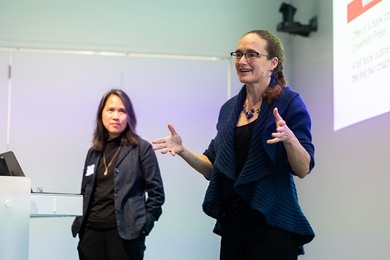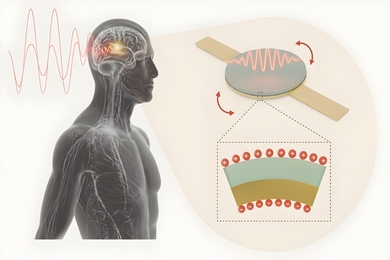Richard M. Held, a professor emeritus and former head of MIT’s Department of Brain and Cognitive Sciences who spent a lifetime investigating the mechanisms of visual perception, died at home of congestive heart failure on Nov. 21. He was 94.
As a faculty member and researcher at three institutions of higher education — Brandeis University, MIT, and the New England College of Optometry — Held pursued a lifelong interest in research on how the visual system develops and adapts, following the advice of Gestalt psychology founder and personal mentor Wolfgang Köhler to “make discoveries.”
Held was born in Manhattan, New York City, on Oct. 10, 1922, the only child of Lawrence W. Held, a shipping export broker, and Tess (Klein) Held, an artist who worked for a time in fashion design. He spent his childhood taking things apart — clocks, locks, and batteries — and then making things, including electric motors and crystal radios, and reading about Tom Swift, the boy inventor.
In a memoir published in 2008 in The History of Neuroscience in Autobiography, Held traced the source of his enduring interest in perception to a 1928 holiday ride with his parents on an excursion boat that sailed from Battery Park to Coney Island. As he recounted, “It was a bright sunny day, and once the boat was in the channel I scanned the water idly looking at birds and boats. At one point I shifted my gaze to the deck on which our chairs sat. I felt a mild shiver as I watched the deck. It was moving under me. What was happening? After a minute or two, I realized that the deck was not going anywhere, it just appeared to move: I would much later learn that this was a paradox that exemplifies the difference between perception and physics.”
As a student at Columbia University, where he earned degrees in engineering and liberal arts, he was influenced by the celebrated art historian and personal mentor Meyer Schapiro, whom he credited with stirring his interest in research through an assignment to write about a piece of art. Held chose Van Gogh’s "Starry Night," observing the depiction of the moon resembled an eclipse, and speculating the painting was an allegory of the Holy Trinity. The essay prompted Schapiro to reference an illuminated medieval manuscript with a similar theme, and crediting Held with it in a journal article. Held wrote of the experience: “It showed me that with motivation, effort, and devotion, one could discover the underlying truths in the world and its artifacts: what I later learned to call research. And, just as important, I COULD DO IT.”
Held served in the Navy in World War II, where he was a tactical radar officer on the USS Kadashan Bay and USS Saratoga in the Pacific, earning the rank of second lieutenant. He was stationed at Eniwetok Atoll, ready for a planned ground invasion, when the war ended after the dropping of the atomic bomb.
After the war, he became a lab assistant to Wolfgang Köhler, who had left Nazi Germany in 1935 for Swarthmore College, co-authoring with him a 1949 Science paper demonstrating that moving a bright object in front of a stationary observer produced a corresponding electrical field in the brain. The paper’s conclusion was called “prophetic” of later research by David Hubel and Torsten Wiesel that vision was made possible by electrical responses in individual neurons.
Held earned a master’s degree from Swarthmore College, a doctorate from Harvard University, and joined the faculty of Brandeis University in 1953 ,where he remained until 1962. There, he conducted with then-graduate student and future MIT Department of Brain and Cognitive Sciences faculty colleague Alan Hein what became his most famous experiment, demonstrating that, in the words of Held’s late French colleague Marc Jeannerod, “perception is constructed by action.” Their work showed the strong role of self-produced movement in visual development: In order to properly judge depth, and distinguish between objects, animals (including humans) need active interaction with the environment. Simply seeing the world and being passively moved in it is not enough.
Two kittens were placed in a carousel, one actively moving itself while pulling a passive mate in a gondola-like cradle. While both kittens were exposed to the same sights, only the kitten actively moving itself was able to acquire the ability to guide itself visually. For example, the active kitten could accurately reach for an object with its paw; the passive kitten could not. Forty-two years later, inspired by those results first published in 1963, researchers at the Swiss Federal Institute of Technology and the Centre for Computational Neuroscience at the University of Sussex reported in a 2005 paper that the same was true for robots capable of collision-free navigation.
In 1962, Held moved to MIT to join then department head Hans-Lukas Teuber in the Department of Experimental Psychology, one of the earliest centers of neuroscience. As the chair of what is now MIT’s Department of Brain and Cognitive Sciences (BCS) from 1977 to 1986, Held mentored several generations of graduate students, and oversaw the department's growth into one of the premiere neuroscience and cognitive science institutions. He was named professor emeritus in 1993.
After retirement from MIT, from 2001 to 2010, he was director of research and graduate education at The New England College of Optometry in Boston, undertaking research with colleagues into the early development of myopia.
In 2003, he joined the MIT laboratory of Pawan Sinha, a professor of vision and computational neuroscience, and became a collaborator in Project Prakash, a non-profit founded by Sinha that restores the sight of congenitally blind children in India and researches their subsequent development of vision. In a paper published in 2011 in Nature Neuroscience titled “The newly sighted fail to match seen with felt,” Held and Sinha reported that newly-sighted subjects who sensed objects with their hands could not identify them by sight — at least at first. However, after a week with sight, their abilities rapidly improved. The findings, which answered a question first posed in 1688, forced a reconsideration of the conventional view that if children lack sight in early childhood, they will never be able to make visual sense of the world. The rapidity of improvement suggested that the visual system is, in some sense, pre-wired, but relies importantly on the feedback between sight and touch that is gained by experience.
"Dick made a remarkable set of contributions to vision science, all with a deep appreciation for the history of which he was part," says Steven Pinker, the Johnstone Family Professor of Psychology at Harvard University. "I had learned about Dick’s work as an undergraduate in Montreal in 1972, and it was a privilege to have been his colleague. He will be missed, but remembered."
Lothar Spillmann, professor of psychology at the National Taiwan University adds: “He was a great scientist and mentor and a beacon of modesty, fairness, and honesty. His passing leaves a tremendous void in the field. To those of us who remember him, he will always be in our hearts and lovingly so.”
Scientific research was a source of pleasure to Held until the end of his life, and he maintained close contact with his colleagues, attending meetings of Sinha’s laboratory until six months before his death. His final paper of more than 200, in which he was a senior author with Sinha as lead author, was published in the Proceedings of the National Academy of Sciences when he was 92 years old — a testament to his unending devotion to research. The paper, “Autism as a disorder of prediction,” laid out a far-reaching theoretic framework to account for multiple aspects of autism, and has already proved influential in guiding empirical studies that seek to understand this complex condition. He died with an open copy of Science News next to his computer keyboard.
Held led an active life, commuting by bicycle to MIT in the 1960s and 1970s at a time when that was rare, and was an avid tennis player into his 60s at the Cambridge Tennis Club. With his wife, he was an enthusiastic member of the Old Cambridge Shakespeare Association, which met monthly to read the works of the Bard aloud. Over the past decade-and-a-half, he was an active member of a memoir-writing group led by Clark C. Abt, the founder of a policy research firm, where his autobiographical sketches revealed a wry sense of humor in finely-crafted prose.
Held was elected to the National Academy of Sciences and was a fellow of the American Academy of Arts and Sciences. He was awarded three honorary doctorates, including one from the Free University of Brussels presented by King Baudouin, and received multiple professional awards including the Galileo Award of the American Foundation for Vision Awareness, the Kenneth Craik Award from Cambridge University, the Howard Crosby Warren Medal from the Society of Experimental Psychologists, and the Glenn A. Fry Award from the American Academy of Optometry.
He is survived by his wife of 65 years, Doris Bernays Held, a retired psychotherapist; three children, Lucas Held of New Haven, Connecticut, Julia Held of Westhampton, Massachusetts, and Andrew Held of Northampton, Massachusetts; and two grandchildren. In June, he and Doris moved to Northampton to be close to their daughter Julia and her family.
In lieu of flowers, donations may be made to Project Prakash, 955 Massachusetts Avenue, Suite 351, Cambridge, MA 02139, or through projectprakash.org. A memorial service will be held on Saturday, May 27, 2017 at Friends Meeting House, 5 Longfellow Park, Cambridge, Massachusetts from 12-2 p.m. Service remarks will begin at 12:30 p.m., followed by a reception from 2-4 p.m. There is very limited on-site parking so guests are advised to look for parking spaces on the neighboring streets or to park at lots in Harvard Square. For information, call the Meeting House at 617-876-6883.






